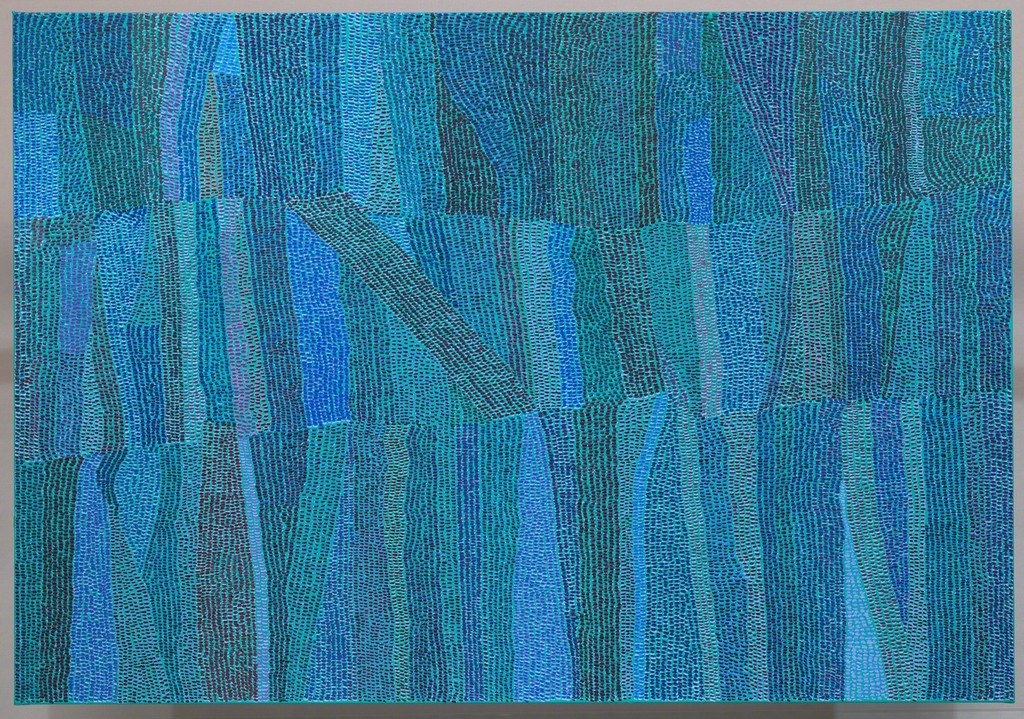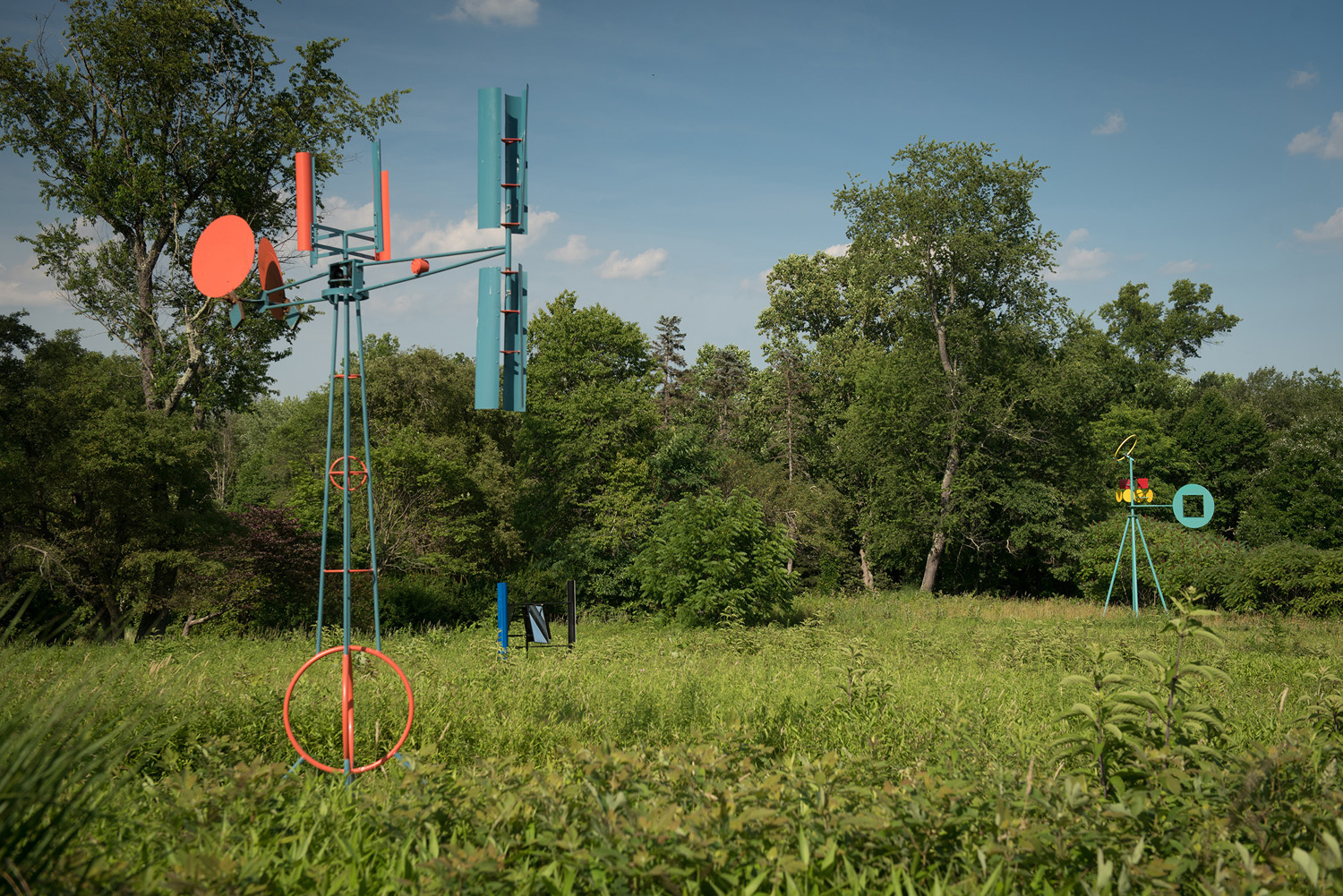Considering Paul Daniel: Acknowledging The Wind at Ladew Topiary Gardens by Timothy App
At this juncture in time, art that deals with pure form, aesthetically inspired phenomena, and sheer beauty may seem anathema. After all, we live in a world plagued with injustice, intolerance, social and political unrest, and bold-faced greed. Making art that merely pleases the eye, that playfully sparks the imagination, or that is quietly contemplative, can be considered to be elitist or even frivolous. Because it does not concern itself with the wide spectrum of social or political issues with which we are now indubitably faced, art that is anchored in beauty and universal principles is often sidelined in favor of art that attempts to grapple with our social and political exigencies. Universals such as reverence for nature, the belief in the power of pure form to communicate meaningfully to a broad audience, or the notion that the usefulness of art is, in the end, its elusiveness, have seemingly gone to the wayside.
Nevertheless, anyone who came of age artistically in the third quarter of the last century, as did the sculptor Paul Daniel, understands implicitly the power of universal precepts and the idealism that spawned them. The notion that fundamental forms act as agents of meaning, espousing that pure form is timeless and meaningful in and of itself, is a basic tenant of Modernism. Geometric forms, for example, brought down through time from antiquity via the Renaissance to the Neo-Classicism in the eighteenth century, and then to Constructivism and Minimalism in the last century, lay claim to this notion of purity in art and its power to communicate broadly.
And along with this understanding comes the belief that the meaning of a work of art is not only expressed through the intent of the artist, with whatever backstory that exists, but also through the work itself, fashioned in the studio by a singular artist’s sensibility, and then made complete by the viewers’ response. This reciprocity of maker and audience, without the aid of a narrative, of symbolism, or even of metaphor, is at the heart of Daniel’s work. The meaning of the work of art, in other words, is to a large extent the result of a symbiosis between the work and the viewer.

Paul Daniel was born and raised in St. Louis, and, as a child whirring about the city on his bicycle, witnessed the construction of the Gateway Arch, a major monument to the idealism of universal principles that defined mid-twentieth century America. That dynamic span of crafted metal erected in the middle of the continent, memorialized westward expansion and symbolized the unification of east and west in this immense country of ours. It represented what many (though certainly not all) thought to be the positive and unifying force of the American spirit. Amid this progressive climate, he studied art at the Kansas City Art Institute under the tutelage of the esteemed sculptor, Dale Eldred, and later for graduate work at MICA with Norman Carlberg. Both Eldred and Carlberg were superb Modernists who confidently formed their art on the principles of universality.
Entering Daniel’s studio is like coming face-to-face with Vulcan, the Roman god of the hearth, of fire, and of the forge. Vulcan was the smithy of the gods, hammering into form, and therefore into existence, the tools, utensils, and weapons of the deity.
Upon entering this factory-like work space in Woodberry, one immediately encounters the sharp clang of hammers forming iron, the fiery spit of welding apparatuses, brazing metals together in a tight bond. One encounters, in real time, the sweat and muscle that is required to handle heavy, stubborn materials being efficaciously fashioned into art. This experience is at once forbidding and exhilarating. With the sights and sounds of this working space, with the piles of massive and unyielding materials all around, and with the results of this visceral activity waiting expectantly to take form, it is difficult to decipher exactly what one is witnessing.
Daniel has an uncontrollable penchant for making things the hard way. He does not design his way into a sculpture so much as he finds and feels his way into it, piece by piece, weld by weld, nut and bolt by nut and bolt, but always measuring twice and cutting once. This intuitive way of working would be cloyingly romantic, even sentimental, if it were not so purposeful. Daniel, with his infinite wisdom about materials, methods and techniques, also knows what works and what does not.
In the realm of sculpture, every constructive decision not only must be aesthetically tuned in, but it must pass the test of functionality. Parts must work, cooperating with, if not obeying, the laws of physics. And when motion is introduced, as it is with most of Daniel’s sculpture, the ante is upped greatly. The weight of gravity and the intransigence of inertia must be overcome. Nothing fails more painfully than a machine that malfunctions. So, at every turn, the stakes are high for Daniel as he fashions these metallic parts and pieces into marvelous and inspired working mechanisms that are, despite all else, aesthetically inspired.

Lurking in the shadows of Daniel’s preference for cold metal is this urge towards actual rather than implied movement–the desire to transform stasis into motion. It is the same urge that prompted artists of the 1950s and 60s to explore kinetics as a primary concern. One thinks immediately of Alexander Calder and his playful and elegant mobiles, or of the tilting aerial spears of George Rickey, a pivotal influence for Daniel. The gargantuan and clunky, yet movable constructions of Mark DiSuvero were also influential. And time traveling to the quattrocento, one cannot help but think of the purposeful contraptions of Leonardo di Vinci, perhaps serving as an early inspiration to all of these artists. And these are but a few of the legion of artists who invited actual movement into their work during this era.
What is it, after all, that inspires this refusal to obey the laws of gravity?
What prompts this impetuous urge to set forms in motion, freeing them from the dictatorial stasis of gravitational pull? Is it only functionality and practicality that drives this necessity? Or does this demand for movement come from the restless dreams of the artist? Or perhaps there is some agitated hint in the materials themselves that entices artists to investigate kinetics. However one poses the question, Daniel has taken up the challenge of inventing the ways and means to facilitate this urge, siding with the dreams of those who precede him as he catapults his sculptures into motion.
Daniel’s current exhibition, Acknowledging The Wind, at Ladew Topiary Gardens in Monkton (the show runs through the end of October) has provided the artist with an extraordinary challenge to expand his dialog with natural phenomena, as well as an opportunity for us to see several of his sculptures all in one place, and in communion with one another. Not only does this installation of seven kinetic sculptures engage the forces of nature, but it also juxtaposes itself with an outdoor site that presents a challenge with scale, given the expanded spacial context of these formal gardens. The sculptures vary in size from ones measuring a few feet in all directions, to the tallest one that measures about twenty feet in height. One ingenious sculpture, “Wind Wirtz Ladew,” dealing with the transference of water via the wind, is situated outside the gardens proper.

All of these works have multiple moving parts generated by the wind. So, it behooves the viewer to visit the site on a windy day in order to experience the full effect of these sculptures. Smaller works are nestled in tall grass, creating a more intimate space for experiencing their movement. The largest work, titled “Kiko-Cy,” towers above the terrain, directing ones gaze upward, effectively utilizing negative shapes to engage the sky.
Still another, “Argus,” employs mirrors along with circular movement that exponentially increases the complexity of interaction between the sculpture itself and the multiple reflections of the observer and the environment. Every sculpture is delightfully kinetic and employs Daniel’s customary use of basic geometric forms, some painted pure primary or secondary colors. This combination of wind-generated movement, primal form, and vivid color draws one very effectively into the mesmerizing immediacy of direct perception, and thus into aesthetic experience for its own invaluable sake.
Although it is highly recommended to experience Daniel’s sculpture at Ladew Gardens, a visit there is not the only way to enjoy his work. All around the city of Baltimore, one may encounter his sculptures, standing alone, whirling and spinning with prompts from the wind. These colorful totems dazzle and delight the sentient observer, much like those at Ladew, and act as mediators between the raw elements of earth and sky, sun and wind interacting with the world of humanly generated color and form. They remind us, through their sculptural ingenuity, of the precarious relationship we have with our immediate environment, and beyond to the cosmos. They put us face to face with that which is infinitely greater than ourselves, just as the “pure” art of the past has done.
Here we experience the efficacy of those universal principles that Daniel and those in his generation learned early on, and that our younger generation–out of distrust perhaps–seems to have jettisoned. We are but a small part of something fantastically larger than ourselves. As we encounter Daniel’s sculptures, the unbearable weight of the world, with its complicated politics, its strife and unrest, its bogus claims for “greatness,” its greed, and of its sad inhumanity to humankind, releases its insidious grip, leaving us to ponder, with a sense of humility and wonder, our place in the infinitely larger scheme of things.
Paul Daniel Acknowledging the Wind: Kinetic Sculptures, will be on display in the Ladew Meadow until October 31, 2018.
Ladew Topiary Gardens, located at 3535 Jarrettsville Pike, Monkton, MD 21111, is open 10am-5pm, 7 days a week.
There is a special event, Garden Glow, on October 20, 5-9pm. http://www.ladewgardens.com
All photos courtesy of John Dean photography.






